Analysis of Innovation and Sustainable Business Development Report
VerifiedAdded on 2020/03/02
|11
|2533
|39
Report
AI Summary
This report delves into the concepts of innovation and sustainable business development, emphasizing the importance of business models in achieving organizational goals. It defines the core elements of a business model, including e-business archetypes, business model as an activity system, and cost-revenue architecture. The report explores various business model conceptualizations, addressing both static and dynamic challenges. It examines the influence of the business context and technological changes. A case study on McDonald's illustrates how a global organization adapts its business model through technology adoption and franchise strategies. The report concludes by highlighting the significance of adapting to industry changes and the value of customer relationships. The findings provide insights into the evolution of business models and the integration of innovation for sustainable growth.
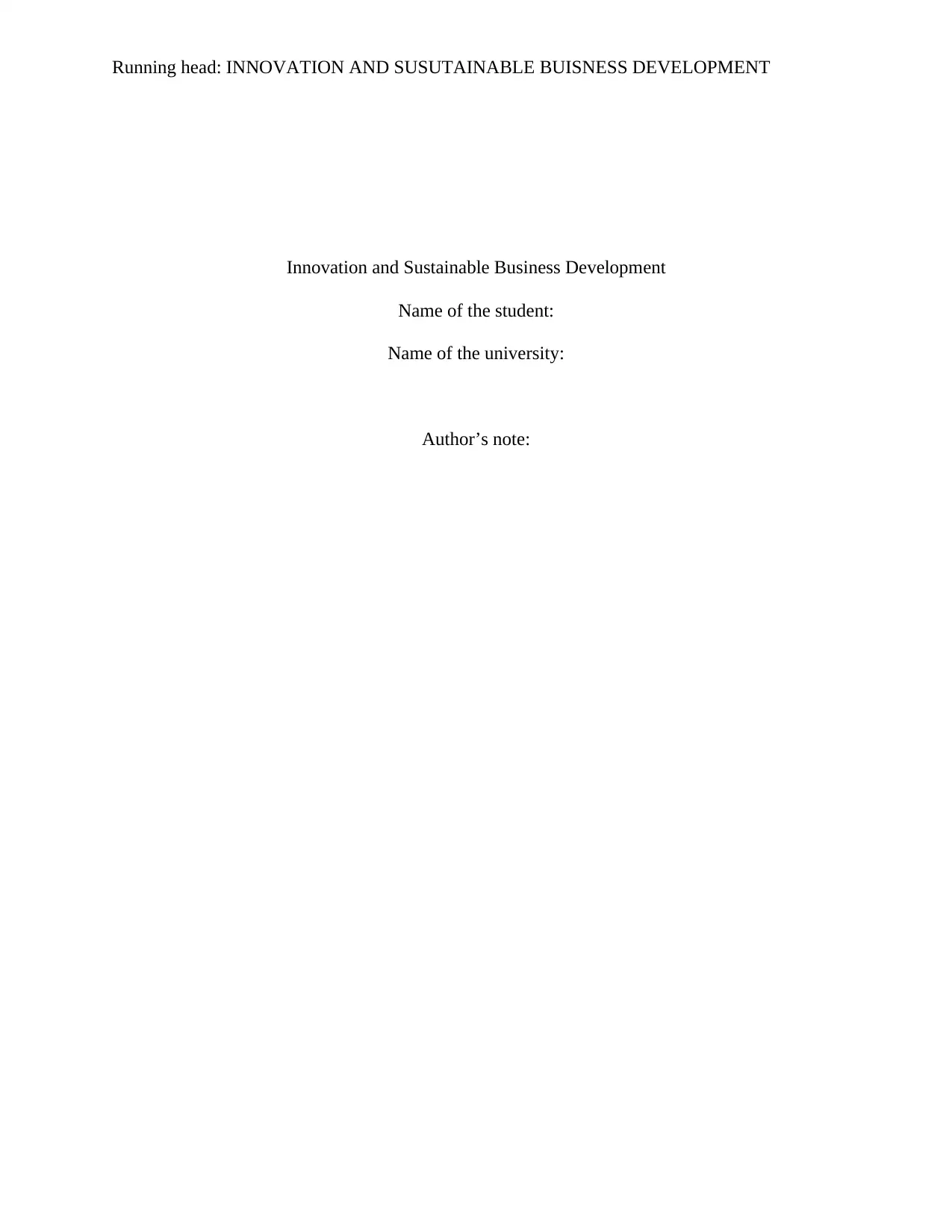
Running head: INNOVATION AND SUSUTAINABLE BUISNESS DEVELOPMENT
Innovation and Sustainable Business Development
Name of the student:
Name of the university:
Author’s note:
Innovation and Sustainable Business Development
Name of the student:
Name of the university:
Author’s note:
Paraphrase This Document
Need a fresh take? Get an instant paraphrase of this document with our AI Paraphraser
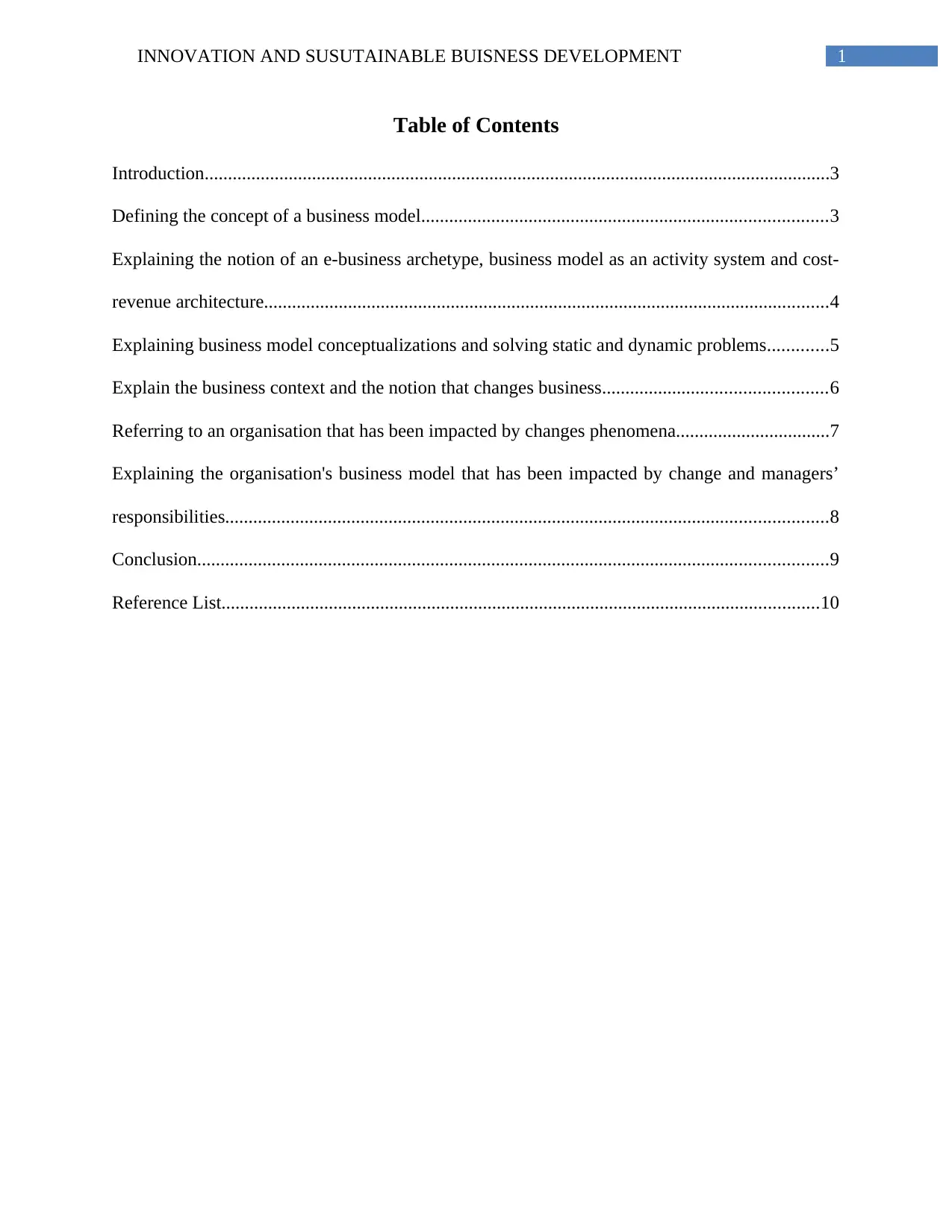
1INNOVATION AND SUSUTAINABLE BUISNESS DEVELOPMENT
Table of Contents
Introduction......................................................................................................................................3
Defining the concept of a business model.......................................................................................3
Explaining the notion of an e-business archetype, business model as an activity system and cost-
revenue architecture.........................................................................................................................4
Explaining business model conceptualizations and solving static and dynamic problems.............5
Explain the business context and the notion that changes business................................................6
Referring to an organisation that has been impacted by changes phenomena.................................7
Explaining the organisation's business model that has been impacted by change and managers’
responsibilities.................................................................................................................................8
Conclusion.......................................................................................................................................9
Reference List................................................................................................................................10
Table of Contents
Introduction......................................................................................................................................3
Defining the concept of a business model.......................................................................................3
Explaining the notion of an e-business archetype, business model as an activity system and cost-
revenue architecture.........................................................................................................................4
Explaining business model conceptualizations and solving static and dynamic problems.............5
Explain the business context and the notion that changes business................................................6
Referring to an organisation that has been impacted by changes phenomena.................................7
Explaining the organisation's business model that has been impacted by change and managers’
responsibilities.................................................................................................................................8
Conclusion.......................................................................................................................................9
Reference List................................................................................................................................10
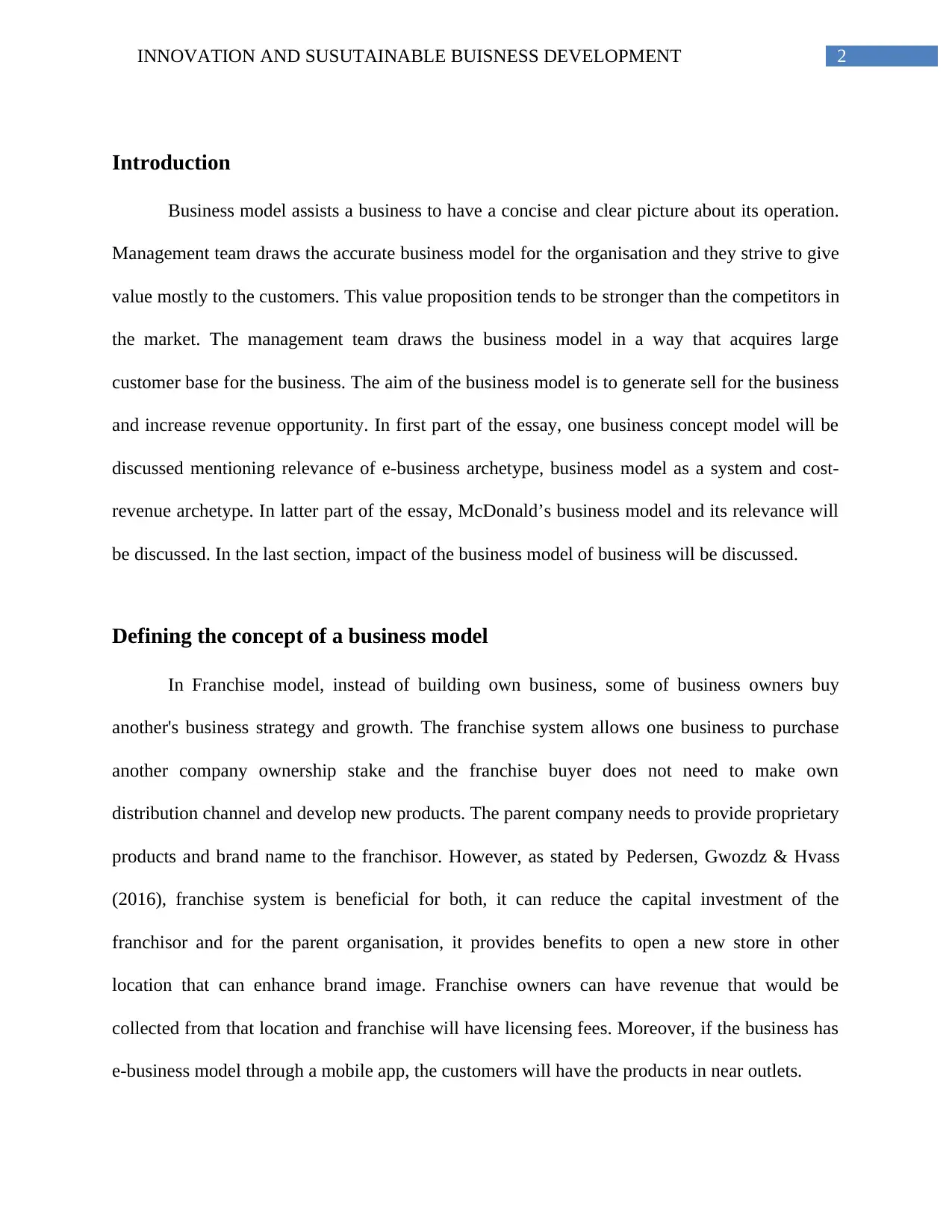
2INNOVATION AND SUSUTAINABLE BUISNESS DEVELOPMENT
Introduction
Business model assists a business to have a concise and clear picture about its operation.
Management team draws the accurate business model for the organisation and they strive to give
value mostly to the customers. This value proposition tends to be stronger than the competitors in
the market. The management team draws the business model in a way that acquires large
customer base for the business. The aim of the business model is to generate sell for the business
and increase revenue opportunity. In first part of the essay, one business concept model will be
discussed mentioning relevance of e-business archetype, business model as a system and cost-
revenue archetype. In latter part of the essay, McDonald’s business model and its relevance will
be discussed. In the last section, impact of the business model of business will be discussed.
Defining the concept of a business model
In Franchise model, instead of building own business, some of business owners buy
another's business strategy and growth. The franchise system allows one business to purchase
another company ownership stake and the franchise buyer does not need to make own
distribution channel and develop new products. The parent company needs to provide proprietary
products and brand name to the franchisor. However, as stated by Pedersen, Gwozdz & Hvass
(2016), franchise system is beneficial for both, it can reduce the capital investment of the
franchisor and for the parent organisation, it provides benefits to open a new store in other
location that can enhance brand image. Franchise owners can have revenue that would be
collected from that location and franchise will have licensing fees. Moreover, if the business has
e-business model through a mobile app, the customers will have the products in near outlets.
Introduction
Business model assists a business to have a concise and clear picture about its operation.
Management team draws the accurate business model for the organisation and they strive to give
value mostly to the customers. This value proposition tends to be stronger than the competitors in
the market. The management team draws the business model in a way that acquires large
customer base for the business. The aim of the business model is to generate sell for the business
and increase revenue opportunity. In first part of the essay, one business concept model will be
discussed mentioning relevance of e-business archetype, business model as a system and cost-
revenue archetype. In latter part of the essay, McDonald’s business model and its relevance will
be discussed. In the last section, impact of the business model of business will be discussed.
Defining the concept of a business model
In Franchise model, instead of building own business, some of business owners buy
another's business strategy and growth. The franchise system allows one business to purchase
another company ownership stake and the franchise buyer does not need to make own
distribution channel and develop new products. The parent company needs to provide proprietary
products and brand name to the franchisor. However, as stated by Pedersen, Gwozdz & Hvass
(2016), franchise system is beneficial for both, it can reduce the capital investment of the
franchisor and for the parent organisation, it provides benefits to open a new store in other
location that can enhance brand image. Franchise owners can have revenue that would be
collected from that location and franchise will have licensing fees. Moreover, if the business has
e-business model through a mobile app, the customers will have the products in near outlets.
⊘ This is a preview!⊘
Do you want full access?
Subscribe today to unlock all pages.

Trusted by 1+ million students worldwide
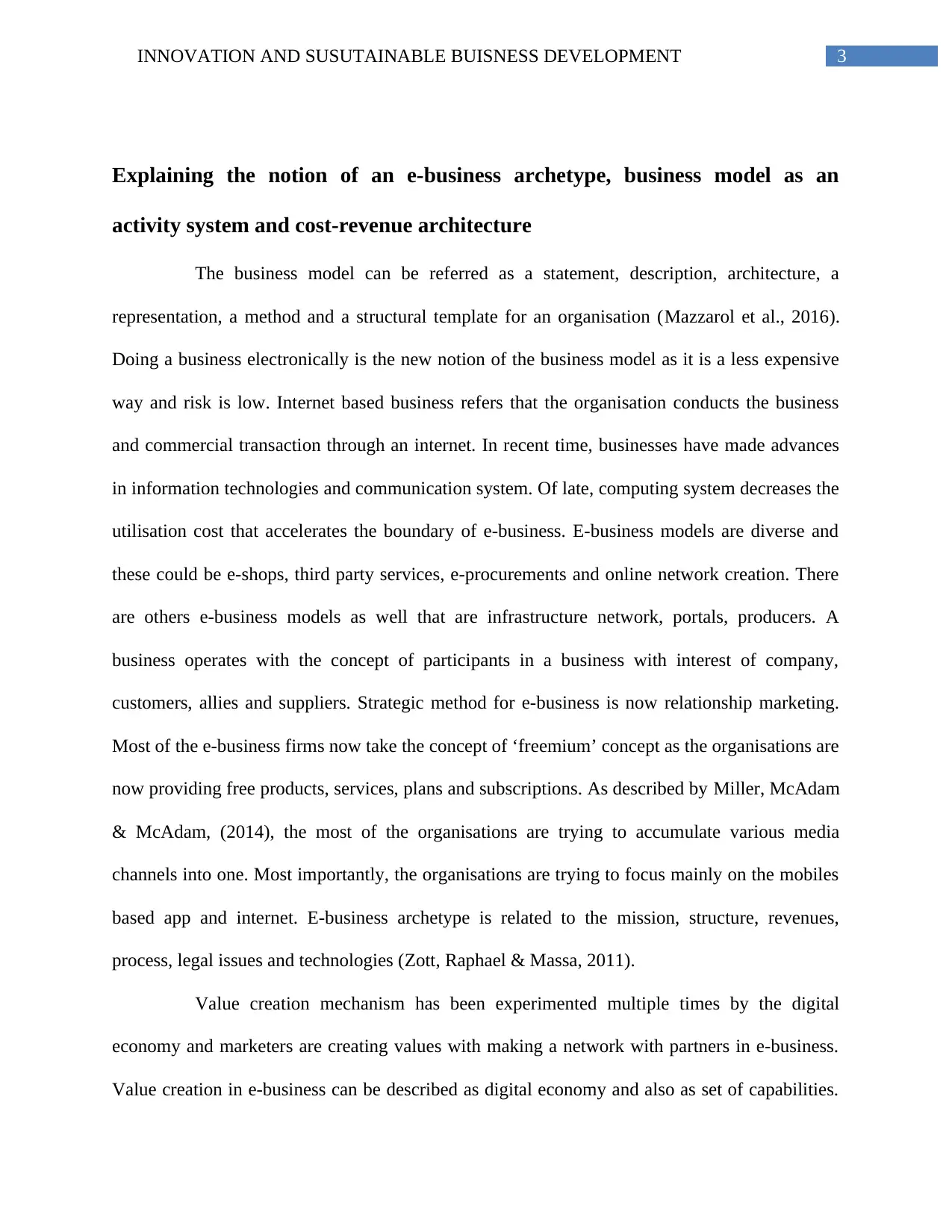
3INNOVATION AND SUSUTAINABLE BUISNESS DEVELOPMENT
Explaining the notion of an e-business archetype, business model as an
activity system and cost-revenue architecture
The business model can be referred as a statement, description, architecture, a
representation, a method and a structural template for an organisation (Mazzarol et al., 2016).
Doing a business electronically is the new notion of the business model as it is a less expensive
way and risk is low. Internet based business refers that the organisation conducts the business
and commercial transaction through an internet. In recent time, businesses have made advances
in information technologies and communication system. Of late, computing system decreases the
utilisation cost that accelerates the boundary of e-business. E-business models are diverse and
these could be e-shops, third party services, e-procurements and online network creation. There
are others e-business models as well that are infrastructure network, portals, producers. A
business operates with the concept of participants in a business with interest of company,
customers, allies and suppliers. Strategic method for e-business is now relationship marketing.
Most of the e-business firms now take the concept of ‘freemium’ concept as the organisations are
now providing free products, services, plans and subscriptions. As described by Miller, McAdam
& McAdam, (2014), the most of the organisations are trying to accumulate various media
channels into one. Most importantly, the organisations are trying to focus mainly on the mobiles
based app and internet. E-business archetype is related to the mission, structure, revenues,
process, legal issues and technologies (Zott, Raphael & Massa, 2011).
Value creation mechanism has been experimented multiple times by the digital
economy and marketers are creating values with making a network with partners in e-business.
Value creation in e-business can be described as digital economy and also as set of capabilities.
Explaining the notion of an e-business archetype, business model as an
activity system and cost-revenue architecture
The business model can be referred as a statement, description, architecture, a
representation, a method and a structural template for an organisation (Mazzarol et al., 2016).
Doing a business electronically is the new notion of the business model as it is a less expensive
way and risk is low. Internet based business refers that the organisation conducts the business
and commercial transaction through an internet. In recent time, businesses have made advances
in information technologies and communication system. Of late, computing system decreases the
utilisation cost that accelerates the boundary of e-business. E-business models are diverse and
these could be e-shops, third party services, e-procurements and online network creation. There
are others e-business models as well that are infrastructure network, portals, producers. A
business operates with the concept of participants in a business with interest of company,
customers, allies and suppliers. Strategic method for e-business is now relationship marketing.
Most of the e-business firms now take the concept of ‘freemium’ concept as the organisations are
now providing free products, services, plans and subscriptions. As described by Miller, McAdam
& McAdam, (2014), the most of the organisations are trying to accumulate various media
channels into one. Most importantly, the organisations are trying to focus mainly on the mobiles
based app and internet. E-business archetype is related to the mission, structure, revenues,
process, legal issues and technologies (Zott, Raphael & Massa, 2011).
Value creation mechanism has been experimented multiple times by the digital
economy and marketers are creating values with making a network with partners in e-business.
Value creation in e-business can be described as digital economy and also as set of capabilities.
Paraphrase This Document
Need a fresh take? Get an instant paraphrase of this document with our AI Paraphraser
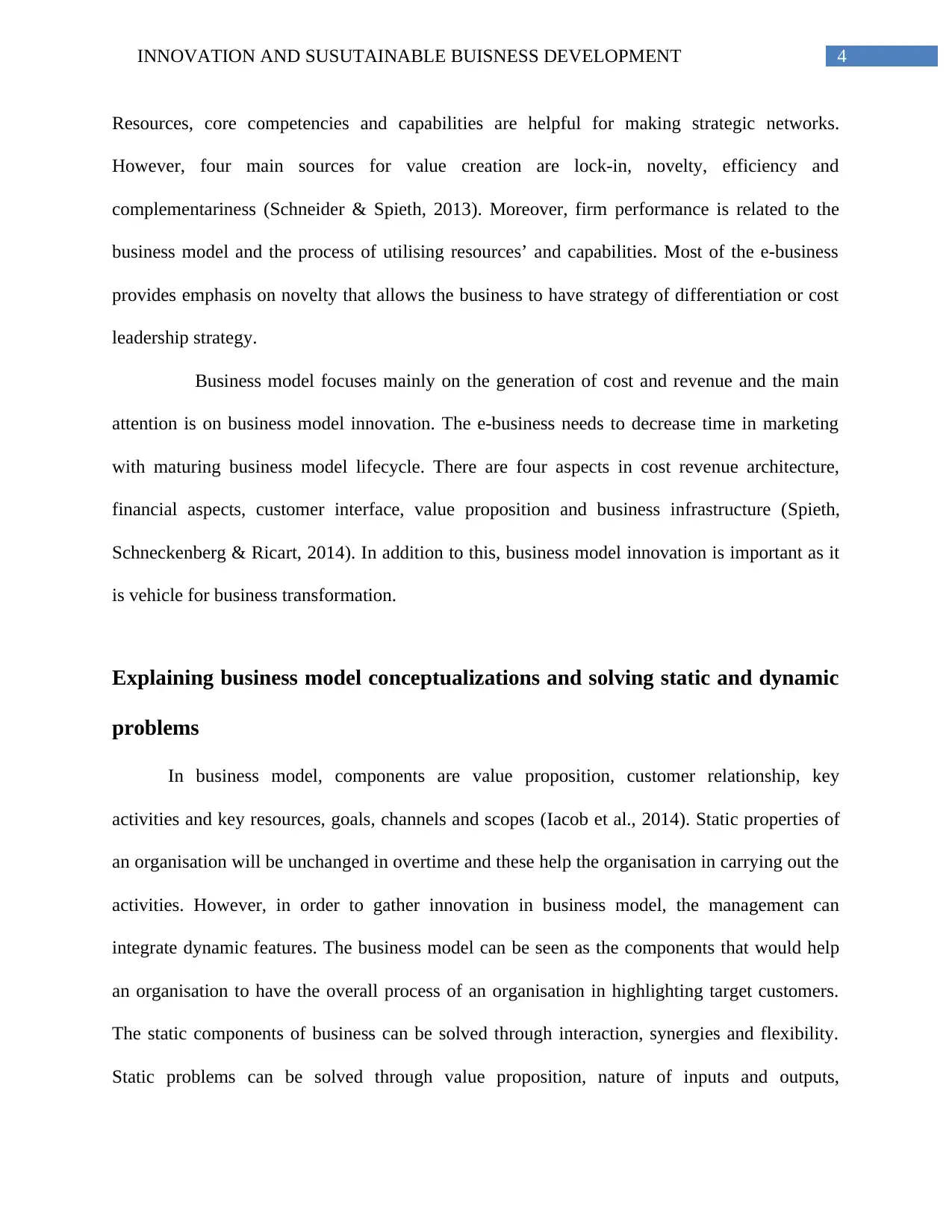
4INNOVATION AND SUSUTAINABLE BUISNESS DEVELOPMENT
Resources, core competencies and capabilities are helpful for making strategic networks.
However, four main sources for value creation are lock-in, novelty, efficiency and
complementariness (Schneider & Spieth, 2013). Moreover, firm performance is related to the
business model and the process of utilising resources’ and capabilities. Most of the e-business
provides emphasis on novelty that allows the business to have strategy of differentiation or cost
leadership strategy.
Business model focuses mainly on the generation of cost and revenue and the main
attention is on business model innovation. The e-business needs to decrease time in marketing
with maturing business model lifecycle. There are four aspects in cost revenue architecture,
financial aspects, customer interface, value proposition and business infrastructure (Spieth,
Schneckenberg & Ricart, 2014). In addition to this, business model innovation is important as it
is vehicle for business transformation.
Explaining business model conceptualizations and solving static and dynamic
problems
In business model, components are value proposition, customer relationship, key
activities and key resources, goals, channels and scopes (Iacob et al., 2014). Static properties of
an organisation will be unchanged in overtime and these help the organisation in carrying out the
activities. However, in order to gather innovation in business model, the management can
integrate dynamic features. The business model can be seen as the components that would help
an organisation to have the overall process of an organisation in highlighting target customers.
The static components of business can be solved through interaction, synergies and flexibility.
Static problems can be solved through value proposition, nature of inputs and outputs,
Resources, core competencies and capabilities are helpful for making strategic networks.
However, four main sources for value creation are lock-in, novelty, efficiency and
complementariness (Schneider & Spieth, 2013). Moreover, firm performance is related to the
business model and the process of utilising resources’ and capabilities. Most of the e-business
provides emphasis on novelty that allows the business to have strategy of differentiation or cost
leadership strategy.
Business model focuses mainly on the generation of cost and revenue and the main
attention is on business model innovation. The e-business needs to decrease time in marketing
with maturing business model lifecycle. There are four aspects in cost revenue architecture,
financial aspects, customer interface, value proposition and business infrastructure (Spieth,
Schneckenberg & Ricart, 2014). In addition to this, business model innovation is important as it
is vehicle for business transformation.
Explaining business model conceptualizations and solving static and dynamic
problems
In business model, components are value proposition, customer relationship, key
activities and key resources, goals, channels and scopes (Iacob et al., 2014). Static properties of
an organisation will be unchanged in overtime and these help the organisation in carrying out the
activities. However, in order to gather innovation in business model, the management can
integrate dynamic features. The business model can be seen as the components that would help
an organisation to have the overall process of an organisation in highlighting target customers.
The static components of business can be solved through interaction, synergies and flexibility.
Static problems can be solved through value proposition, nature of inputs and outputs,
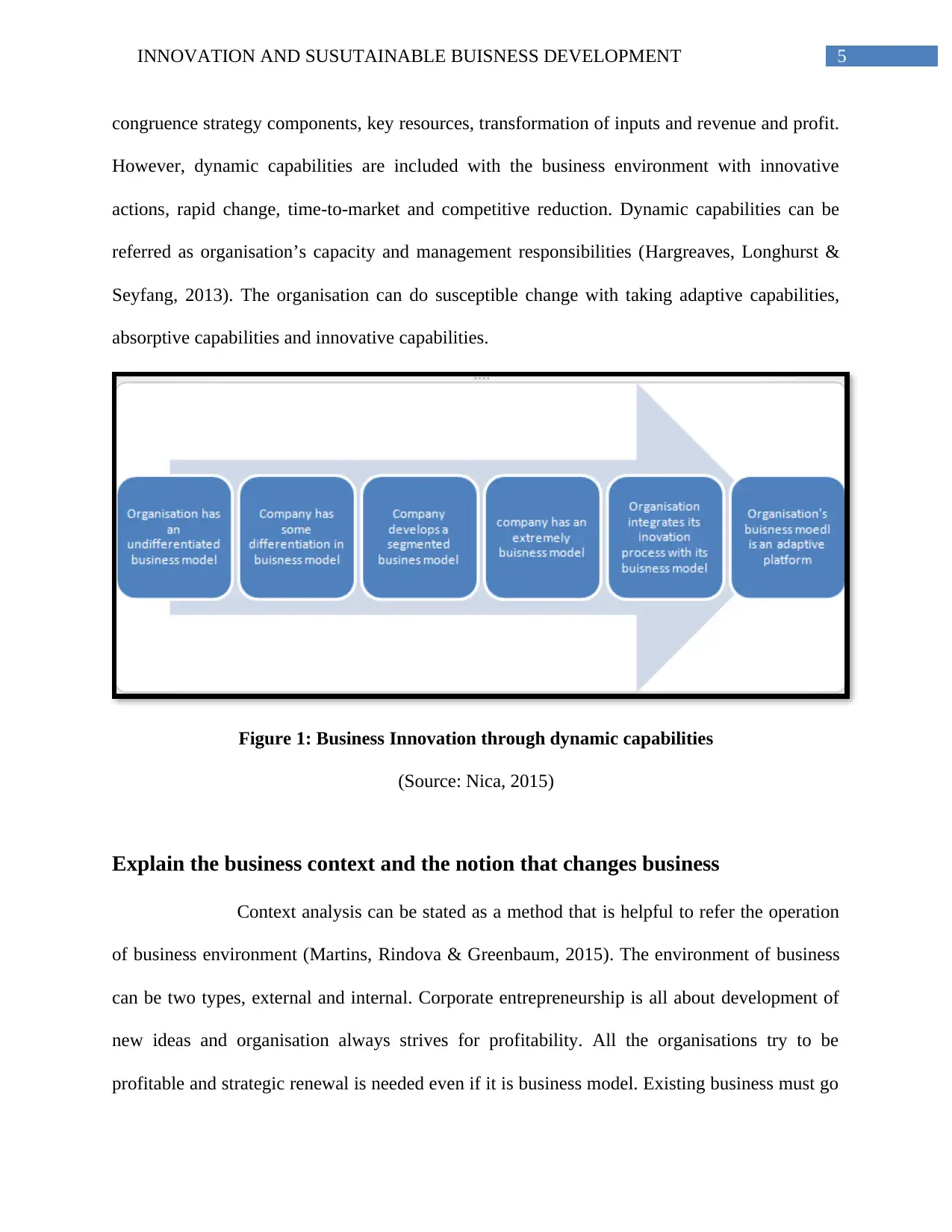
5INNOVATION AND SUSUTAINABLE BUISNESS DEVELOPMENT
congruence strategy components, key resources, transformation of inputs and revenue and profit.
However, dynamic capabilities are included with the business environment with innovative
actions, rapid change, time-to-market and competitive reduction. Dynamic capabilities can be
referred as organisation’s capacity and management responsibilities (Hargreaves, Longhurst &
Seyfang, 2013). The organisation can do susceptible change with taking adaptive capabilities,
absorptive capabilities and innovative capabilities.
Figure 1: Business Innovation through dynamic capabilities
(Source: Nica, 2015)
Explain the business context and the notion that changes business
Context analysis can be stated as a method that is helpful to refer the operation
of business environment (Martins, Rindova & Greenbaum, 2015). The environment of business
can be two types, external and internal. Corporate entrepreneurship is all about development of
new ideas and organisation always strives for profitability. All the organisations try to be
profitable and strategic renewal is needed even if it is business model. Existing business must go
congruence strategy components, key resources, transformation of inputs and revenue and profit.
However, dynamic capabilities are included with the business environment with innovative
actions, rapid change, time-to-market and competitive reduction. Dynamic capabilities can be
referred as organisation’s capacity and management responsibilities (Hargreaves, Longhurst &
Seyfang, 2013). The organisation can do susceptible change with taking adaptive capabilities,
absorptive capabilities and innovative capabilities.
Figure 1: Business Innovation through dynamic capabilities
(Source: Nica, 2015)
Explain the business context and the notion that changes business
Context analysis can be stated as a method that is helpful to refer the operation
of business environment (Martins, Rindova & Greenbaum, 2015). The environment of business
can be two types, external and internal. Corporate entrepreneurship is all about development of
new ideas and organisation always strives for profitability. All the organisations try to be
profitable and strategic renewal is needed even if it is business model. Existing business must go
⊘ This is a preview!⊘
Do you want full access?
Subscribe today to unlock all pages.

Trusted by 1+ million students worldwide
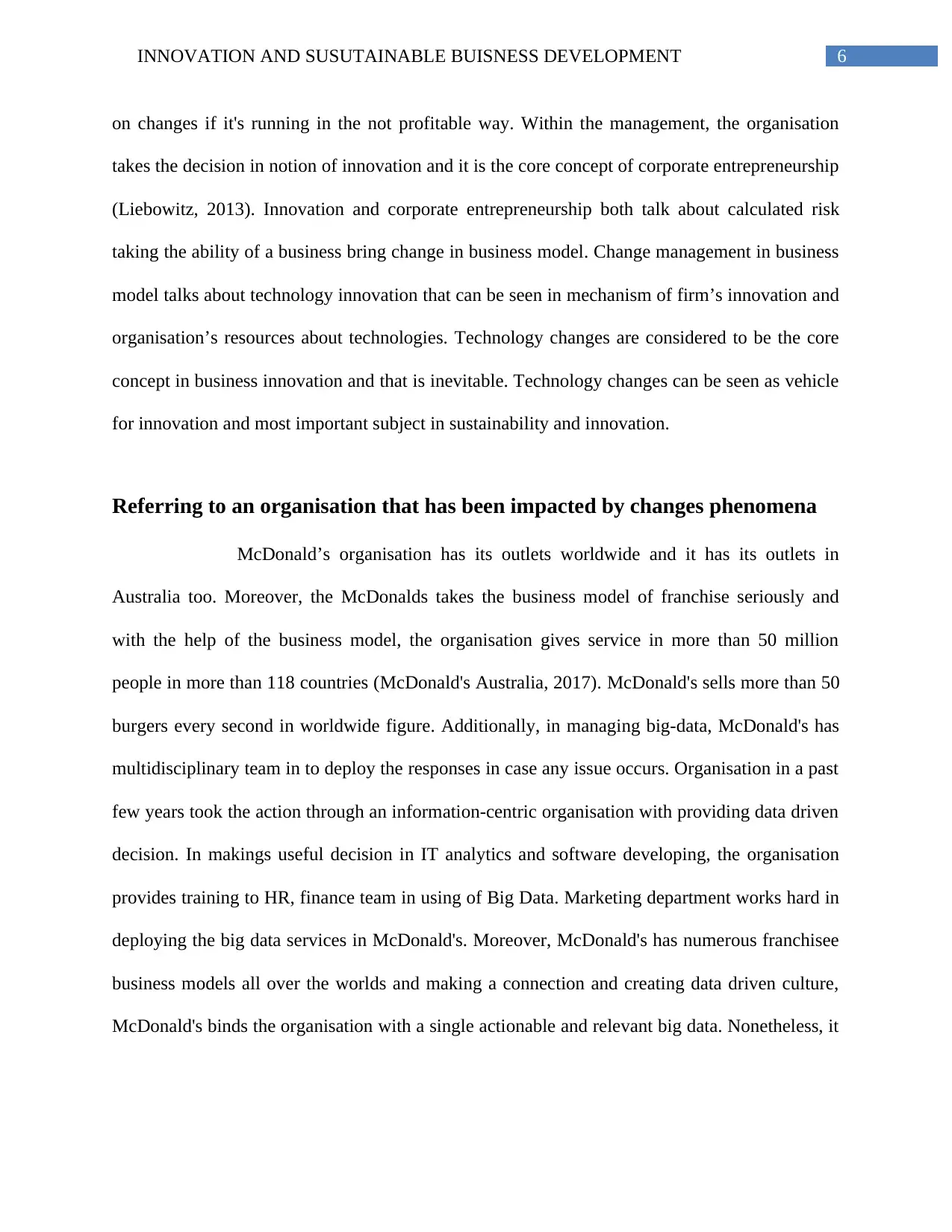
6INNOVATION AND SUSUTAINABLE BUISNESS DEVELOPMENT
on changes if it's running in the not profitable way. Within the management, the organisation
takes the decision in notion of innovation and it is the core concept of corporate entrepreneurship
(Liebowitz, 2013). Innovation and corporate entrepreneurship both talk about calculated risk
taking the ability of a business bring change in business model. Change management in business
model talks about technology innovation that can be seen in mechanism of firm’s innovation and
organisation’s resources about technologies. Technology changes are considered to be the core
concept in business innovation and that is inevitable. Technology changes can be seen as vehicle
for innovation and most important subject in sustainability and innovation.
Referring to an organisation that has been impacted by changes phenomena
McDonald’s organisation has its outlets worldwide and it has its outlets in
Australia too. Moreover, the McDonalds takes the business model of franchise seriously and
with the help of the business model, the organisation gives service in more than 50 million
people in more than 118 countries (McDonald's Australia, 2017). McDonald's sells more than 50
burgers every second in worldwide figure. Additionally, in managing big-data, McDonald's has
multidisciplinary team in to deploy the responses in case any issue occurs. Organisation in a past
few years took the action through an information-centric organisation with providing data driven
decision. In makings useful decision in IT analytics and software developing, the organisation
provides training to HR, finance team in using of Big Data. Marketing department works hard in
deploying the big data services in McDonald's. Moreover, McDonald's has numerous franchisee
business models all over the worlds and making a connection and creating data driven culture,
McDonald's binds the organisation with a single actionable and relevant big data. Nonetheless, it
on changes if it's running in the not profitable way. Within the management, the organisation
takes the decision in notion of innovation and it is the core concept of corporate entrepreneurship
(Liebowitz, 2013). Innovation and corporate entrepreneurship both talk about calculated risk
taking the ability of a business bring change in business model. Change management in business
model talks about technology innovation that can be seen in mechanism of firm’s innovation and
organisation’s resources about technologies. Technology changes are considered to be the core
concept in business innovation and that is inevitable. Technology changes can be seen as vehicle
for innovation and most important subject in sustainability and innovation.
Referring to an organisation that has been impacted by changes phenomena
McDonald’s organisation has its outlets worldwide and it has its outlets in
Australia too. Moreover, the McDonalds takes the business model of franchise seriously and
with the help of the business model, the organisation gives service in more than 50 million
people in more than 118 countries (McDonald's Australia, 2017). McDonald's sells more than 50
burgers every second in worldwide figure. Additionally, in managing big-data, McDonald's has
multidisciplinary team in to deploy the responses in case any issue occurs. Organisation in a past
few years took the action through an information-centric organisation with providing data driven
decision. In makings useful decision in IT analytics and software developing, the organisation
provides training to HR, finance team in using of Big Data. Marketing department works hard in
deploying the big data services in McDonald's. Moreover, McDonald's has numerous franchisee
business models all over the worlds and making a connection and creating data driven culture,
McDonald's binds the organisation with a single actionable and relevant big data. Nonetheless, it
Paraphrase This Document
Need a fresh take? Get an instant paraphrase of this document with our AI Paraphraser
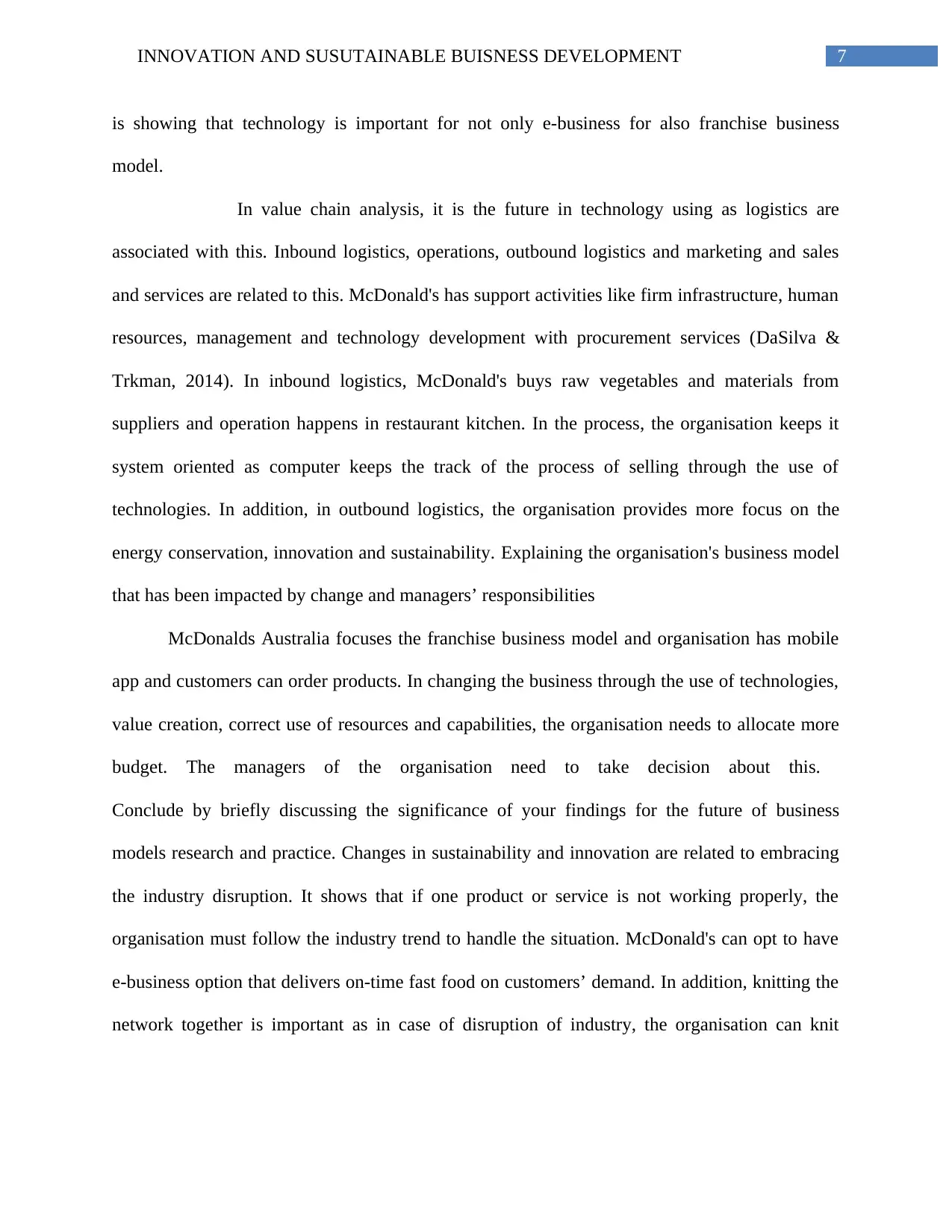
7INNOVATION AND SUSUTAINABLE BUISNESS DEVELOPMENT
is showing that technology is important for not only e-business for also franchise business
model.
In value chain analysis, it is the future in technology using as logistics are
associated with this. Inbound logistics, operations, outbound logistics and marketing and sales
and services are related to this. McDonald's has support activities like firm infrastructure, human
resources, management and technology development with procurement services (DaSilva &
Trkman, 2014). In inbound logistics, McDonald's buys raw vegetables and materials from
suppliers and operation happens in restaurant kitchen. In the process, the organisation keeps it
system oriented as computer keeps the track of the process of selling through the use of
technologies. In addition, in outbound logistics, the organisation provides more focus on the
energy conservation, innovation and sustainability. Explaining the organisation's business model
that has been impacted by change and managers’ responsibilities
McDonalds Australia focuses the franchise business model and organisation has mobile
app and customers can order products. In changing the business through the use of technologies,
value creation, correct use of resources and capabilities, the organisation needs to allocate more
budget. The managers of the organisation need to take decision about this.
Conclude by briefly discussing the significance of your findings for the future of business
models research and practice. Changes in sustainability and innovation are related to embracing
the industry disruption. It shows that if one product or service is not working properly, the
organisation must follow the industry trend to handle the situation. McDonald's can opt to have
e-business option that delivers on-time fast food on customers’ demand. In addition, knitting the
network together is important as in case of disruption of industry, the organisation can knit
is showing that technology is important for not only e-business for also franchise business
model.
In value chain analysis, it is the future in technology using as logistics are
associated with this. Inbound logistics, operations, outbound logistics and marketing and sales
and services are related to this. McDonald's has support activities like firm infrastructure, human
resources, management and technology development with procurement services (DaSilva &
Trkman, 2014). In inbound logistics, McDonald's buys raw vegetables and materials from
suppliers and operation happens in restaurant kitchen. In the process, the organisation keeps it
system oriented as computer keeps the track of the process of selling through the use of
technologies. In addition, in outbound logistics, the organisation provides more focus on the
energy conservation, innovation and sustainability. Explaining the organisation's business model
that has been impacted by change and managers’ responsibilities
McDonalds Australia focuses the franchise business model and organisation has mobile
app and customers can order products. In changing the business through the use of technologies,
value creation, correct use of resources and capabilities, the organisation needs to allocate more
budget. The managers of the organisation need to take decision about this.
Conclude by briefly discussing the significance of your findings for the future of business
models research and practice. Changes in sustainability and innovation are related to embracing
the industry disruption. It shows that if one product or service is not working properly, the
organisation must follow the industry trend to handle the situation. McDonald's can opt to have
e-business option that delivers on-time fast food on customers’ demand. In addition, knitting the
network together is important as in case of disruption of industry, the organisation can knit
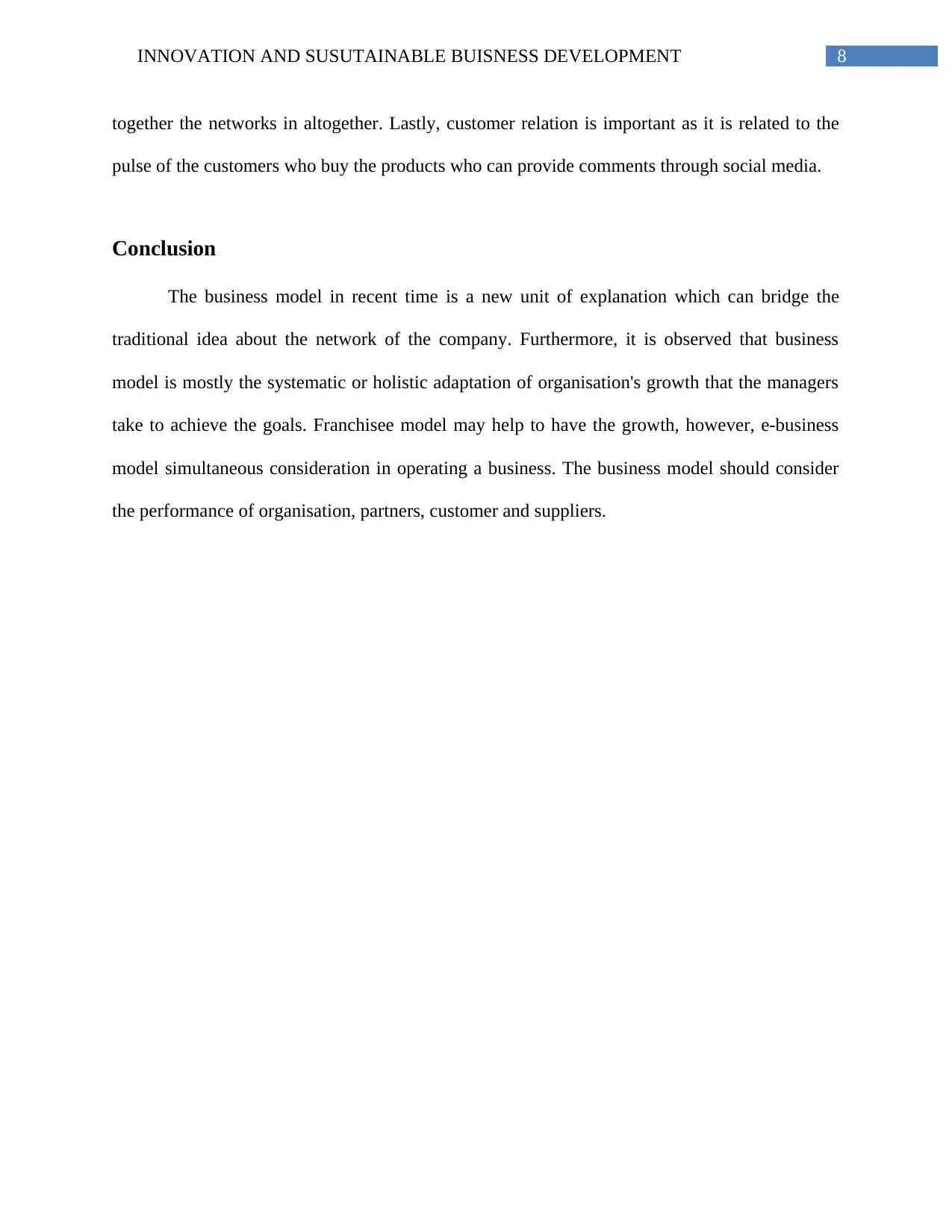
8INNOVATION AND SUSUTAINABLE BUISNESS DEVELOPMENT
together the networks in altogether. Lastly, customer relation is important as it is related to the
pulse of the customers who buy the products who can provide comments through social media.
Conclusion
The business model in recent time is a new unit of explanation which can bridge the
traditional idea about the network of the company. Furthermore, it is observed that business
model is mostly the systematic or holistic adaptation of organisation's growth that the managers
take to achieve the goals. Franchisee model may help to have the growth, however, e-business
model simultaneous consideration in operating a business. The business model should consider
the performance of organisation, partners, customer and suppliers.
together the networks in altogether. Lastly, customer relation is important as it is related to the
pulse of the customers who buy the products who can provide comments through social media.
Conclusion
The business model in recent time is a new unit of explanation which can bridge the
traditional idea about the network of the company. Furthermore, it is observed that business
model is mostly the systematic or holistic adaptation of organisation's growth that the managers
take to achieve the goals. Franchisee model may help to have the growth, however, e-business
model simultaneous consideration in operating a business. The business model should consider
the performance of organisation, partners, customer and suppliers.
⊘ This is a preview!⊘
Do you want full access?
Subscribe today to unlock all pages.

Trusted by 1+ million students worldwide
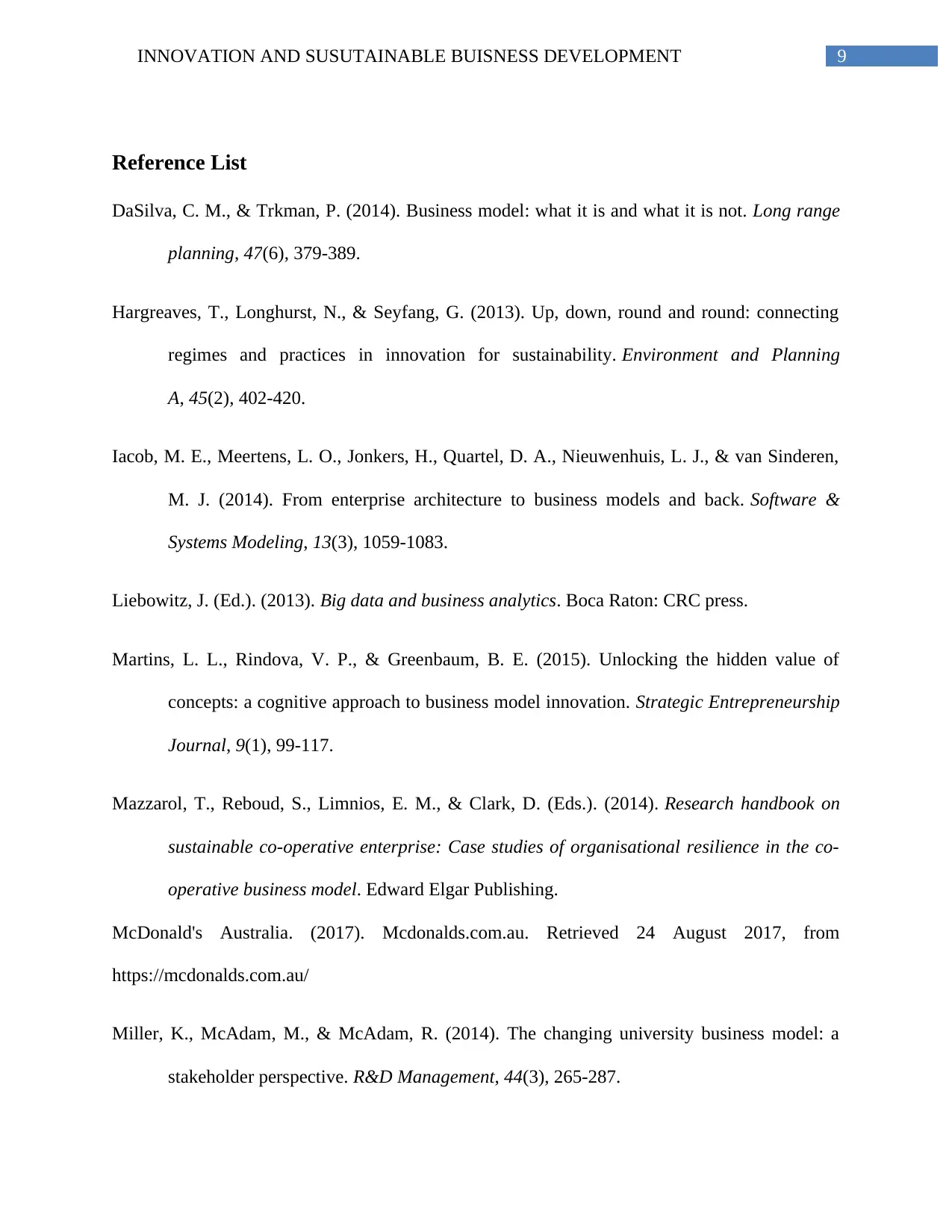
9INNOVATION AND SUSUTAINABLE BUISNESS DEVELOPMENT
Reference List
DaSilva, C. M., & Trkman, P. (2014). Business model: what it is and what it is not. Long range
planning, 47(6), 379-389.
Hargreaves, T., Longhurst, N., & Seyfang, G. (2013). Up, down, round and round: connecting
regimes and practices in innovation for sustainability. Environment and Planning
A, 45(2), 402-420.
Iacob, M. E., Meertens, L. O., Jonkers, H., Quartel, D. A., Nieuwenhuis, L. J., & van Sinderen,
M. J. (2014). From enterprise architecture to business models and back. Software &
Systems Modeling, 13(3), 1059-1083.
Liebowitz, J. (Ed.). (2013). Big data and business analytics. Boca Raton: CRC press.
Martins, L. L., Rindova, V. P., & Greenbaum, B. E. (2015). Unlocking the hidden value of
concepts: a cognitive approach to business model innovation. Strategic Entrepreneurship
Journal, 9(1), 99-117.
Mazzarol, T., Reboud, S., Limnios, E. M., & Clark, D. (Eds.). (2014). Research handbook on
sustainable co-operative enterprise: Case studies of organisational resilience in the co-
operative business model. Edward Elgar Publishing.
McDonald's Australia. (2017). Mcdonalds.com.au. Retrieved 24 August 2017, from
https://mcdonalds.com.au/
Miller, K., McAdam, M., & McAdam, R. (2014). The changing university business model: a
stakeholder perspective. R&D Management, 44(3), 265-287.
Reference List
DaSilva, C. M., & Trkman, P. (2014). Business model: what it is and what it is not. Long range
planning, 47(6), 379-389.
Hargreaves, T., Longhurst, N., & Seyfang, G. (2013). Up, down, round and round: connecting
regimes and practices in innovation for sustainability. Environment and Planning
A, 45(2), 402-420.
Iacob, M. E., Meertens, L. O., Jonkers, H., Quartel, D. A., Nieuwenhuis, L. J., & van Sinderen,
M. J. (2014). From enterprise architecture to business models and back. Software &
Systems Modeling, 13(3), 1059-1083.
Liebowitz, J. (Ed.). (2013). Big data and business analytics. Boca Raton: CRC press.
Martins, L. L., Rindova, V. P., & Greenbaum, B. E. (2015). Unlocking the hidden value of
concepts: a cognitive approach to business model innovation. Strategic Entrepreneurship
Journal, 9(1), 99-117.
Mazzarol, T., Reboud, S., Limnios, E. M., & Clark, D. (Eds.). (2014). Research handbook on
sustainable co-operative enterprise: Case studies of organisational resilience in the co-
operative business model. Edward Elgar Publishing.
McDonald's Australia. (2017). Mcdonalds.com.au. Retrieved 24 August 2017, from
https://mcdonalds.com.au/
Miller, K., McAdam, M., & McAdam, R. (2014). The changing university business model: a
stakeholder perspective. R&D Management, 44(3), 265-287.
Paraphrase This Document
Need a fresh take? Get an instant paraphrase of this document with our AI Paraphraser
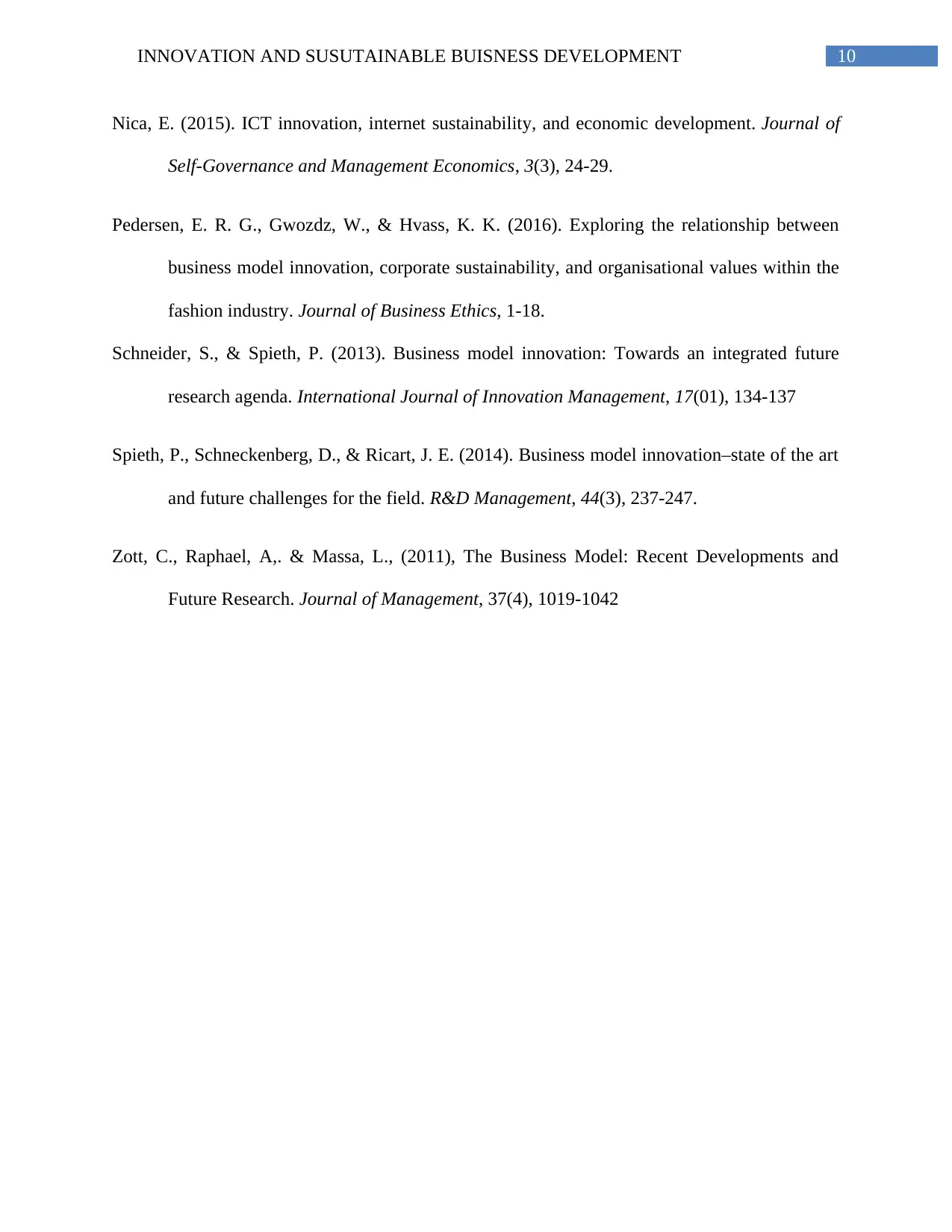
10INNOVATION AND SUSUTAINABLE BUISNESS DEVELOPMENT
Nica, E. (2015). ICT innovation, internet sustainability, and economic development. Journal of
Self-Governance and Management Economics, 3(3), 24-29.
Pedersen, E. R. G., Gwozdz, W., & Hvass, K. K. (2016). Exploring the relationship between
business model innovation, corporate sustainability, and organisational values within the
fashion industry. Journal of Business Ethics, 1-18.
Schneider, S., & Spieth, P. (2013). Business model innovation: Towards an integrated future
research agenda. International Journal of Innovation Management, 17(01), 134-137
Spieth, P., Schneckenberg, D., & Ricart, J. E. (2014). Business model innovation–state of the art
and future challenges for the field. R&D Management, 44(3), 237-247.
Zott, C., Raphael, A,. & Massa, L., (2011), The Business Model: Recent Developments and
Future Research. Journal of Management, 37(4), 1019-1042
Nica, E. (2015). ICT innovation, internet sustainability, and economic development. Journal of
Self-Governance and Management Economics, 3(3), 24-29.
Pedersen, E. R. G., Gwozdz, W., & Hvass, K. K. (2016). Exploring the relationship between
business model innovation, corporate sustainability, and organisational values within the
fashion industry. Journal of Business Ethics, 1-18.
Schneider, S., & Spieth, P. (2013). Business model innovation: Towards an integrated future
research agenda. International Journal of Innovation Management, 17(01), 134-137
Spieth, P., Schneckenberg, D., & Ricart, J. E. (2014). Business model innovation–state of the art
and future challenges for the field. R&D Management, 44(3), 237-247.
Zott, C., Raphael, A,. & Massa, L., (2011), The Business Model: Recent Developments and
Future Research. Journal of Management, 37(4), 1019-1042
1 out of 11
Related Documents
Your All-in-One AI-Powered Toolkit for Academic Success.
+13062052269
info@desklib.com
Available 24*7 on WhatsApp / Email
![[object Object]](/_next/static/media/star-bottom.7253800d.svg)
Unlock your academic potential
Copyright © 2020–2025 A2Z Services. All Rights Reserved. Developed and managed by ZUCOL.





